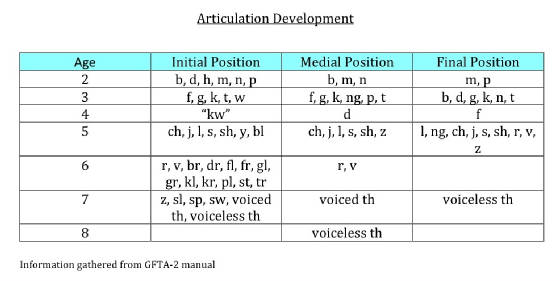


“boo” for “book”)Īrticulation errors come from producing a sound inaccurately, based on the placement of the articulators in the mouth, distorting the sound we hear. Final Consonant Deletion: leaving off ending sounds in words.Stopping: When an air flow sound like /s/ or /z/ is consistently replaced with a stop such as /t/.This typically resolves by 3.5 years old. Backing: When velar/back sounds, /k, g/ are replaced with alveolar/front sounds, /t, d/.These errors are considered “expected,” so long as they do not persist past the age of elimination. These are called Phonological Processes and are common substitutions or distortions of sounds that fade as the child gets older. These errors come from two different concepts: Speech Sounds – PhonologyĪll children make predictable errors as they are learning to talk like adults. Speech errors can be expected and age appropriate or unexpected. At 24 months, children are 50-75% intelligible and should be approaching 100% intelligibility at age three. By 18 months, a child should be at least 25% intelligible to their family, meaning that parents understand about a quarter of what is said. The maximal oppositions approach pairs one sound that is known (i.e., used) by the child and one sound that is unknown (i.e., not used) by the child in non-homonymous contrasts.It’s an exciting time when your child starts using words to communicate…but when do speech sound errors like “tar” for “car” go from cute and age appropriate, to areas of concern? Specific sounds and speech patterns develop at different times, improving how well a child is understood by their parents, peers, and caretakers. … Children usually make this error with words until they are about 3 years of age. Liquid (/r/, /l/) is replaced with a glide (/w/, /j/)įinal consonant deletion is a phonological process in language where children delete the final consonant off words. When should Deaffrication be eliminated? Assimilation (Consonant Harmony) One sound becomes the same or similar to another sound in the word The mistakes may be common in young children learning speech skills, but when they continue past a certain age, it may be a disorder. Phonological process disorders: A phonological process disorder occurs when a child makes predictable and typical patterns of speech sound errors.

What is a phonological processing disorder? A phonological delay can impact a child’s production of certain sounds making their speech unclear. When a child has a phonological delay they are following a typical pattern of speech development but are demonstrating developmental phonological errors that typically should have disappeared 6 or more months earlier. Is phonological disorder a developmental delay? Is cycles approach evidence based?Ĭonclusion: Considering the research studies over the past three decades, Cycles Approach can be considered as an evidence-based treatment and the therapists can apply it as an appropriate method to interfere with the speech sound disorders in children having moderate to severe phonological disorders. The broad category of phonological processing includes phonological awareness, phonological working memory, and phonological retrieval. Phonological processing is the use of the sounds of one’s language (i.e., phonemes) to process spoken and written language (Wagner & Torgesen, 1987). Among the phonological or linguistic intervention approaches are a group referred to as contrast approaches. Phonological or linguistic approaches focus on the function of sounds to differentiate meanings, error patterns, and phonological rules that may be underlying the errors. (1988) found cluster reduction and gliding of liquid consonants to be the most frequently used phonological processes among the subjects. Which phonological processes affect intelligibility the most? Traditionally, ‘stimulable’ has meant that a consonant or vowel can be produced in isolation by a child, in direct imitation of an auditory and visual model with or without instructions, cues, imagery, feedback and encouragement. It can also be used with people who are looking to modify their accent. Who is it for? The Minimal Pairs Approach is suitable for children with mild or moderate speech sound disorders, with one or two phonological processes that are no longer age-appropriate. The Cycles Approach (Hodson & Paden, 1983, 1991) addresses a child’s use of phonological processes by cyclically targeting affected sound classes. The Cycles Approach (Hodson & Paden, 1983, 1991) is an intervention method used with severe phonological disorders.


 0 kommentar(er)
0 kommentar(er)
